Related sites:
Newsletter: Perspectives on Power Platform
Company: Niiranen Advisory Oy
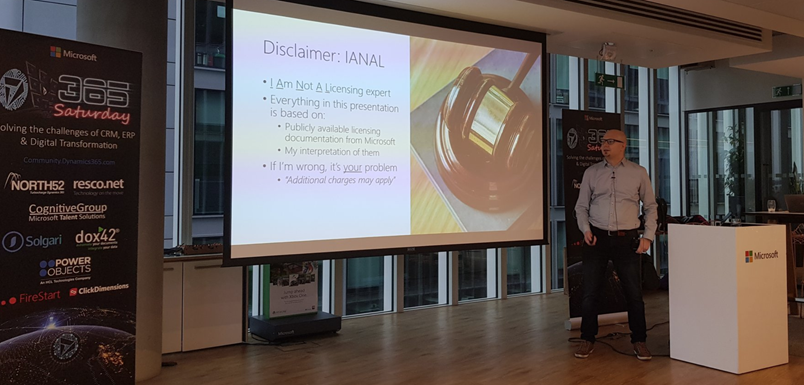
In the previous post I highlighted some of the recent updates on Dynamics 365 licensing. Now let’s have a look at how the birth of Power Platform has further expanded the licensing options for delivering business applications to customers. Just like before, the content is taken from my session at Dynamics Power 365 Saturday London 2019 and you’ll find the complete slide deck on SlideShare my Slides archive:
Common Data Service for Apps (CDS) environment is essentially the same as a Dynamics 365 Customer Engagement instance, just without the first party apps from Microsoft. If you can get CDS both via PowerApps license as well as Dynamics 365, then it’s important to understand what the subtle differences there may be. Currently at least these features are missing from a pure CDS environment when you provision it for PowerApps and not Dynamics 365:
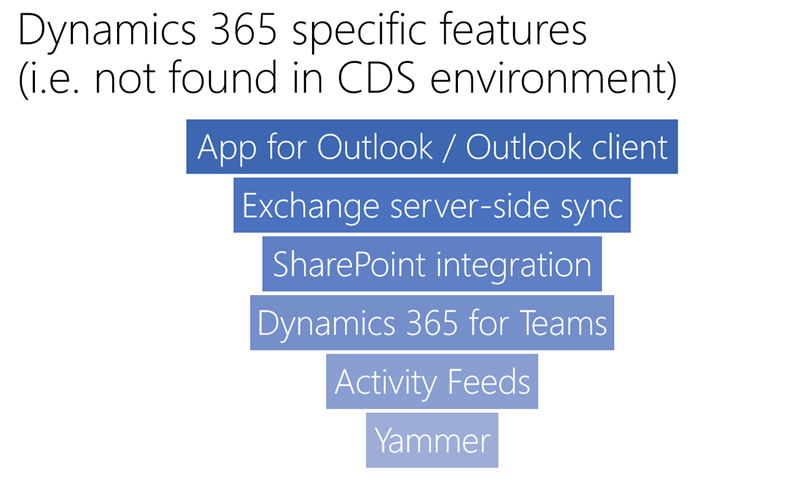
There are interesting differences in how the licenses grant you resources when comparing Dynamics 365 CE and PowerApps. On the storage side you get the same starting 10 GB per tenant and as you purchase more user licenses they give you more storage quota. As for the actual instance/environment count, on the Dynamics 365 side you need to pay for additional sandbox and production instances (roughly €125 & €460 per month). PowerApps is far more generous in this sense, as each P2 user license gives you 2 environments. With 100 users you could therefore have 200 environments for your organization, which sound like a ludicrous amount if you’d think of them as CRM instances. That’s where the broader business application scope of Power Platform and the citizen developer mindset clearly differs from the Dynamics way of doing things in a controlled, centralized manner.
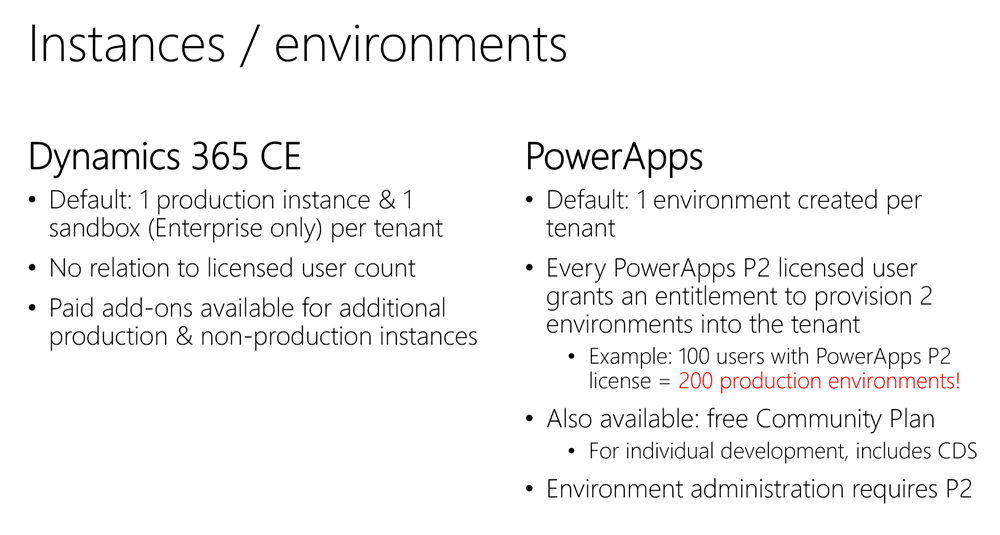
One area which Microsoft has left very unclear in their licensing documentation is what level of PowerApps user rights are included in the non-Enterprise Dynamics 365 licenses. A recent presentation finally listed the restrictions that licenses like Team Member, Sales Professional and Customer Service Professional face in their ability to leverage PowerApps. With the new feature that allows embedding canvas apps into model-driven app forms, the rights of all Dynamics 365 licenses now do include access to these embedded experiences. However, running any standalone PowerApps canvas app is NOT included in these cheaper licenses, so you’ll need a separate license for those scenarios (like PowerApps P1, or the rights bundled in Office 365).
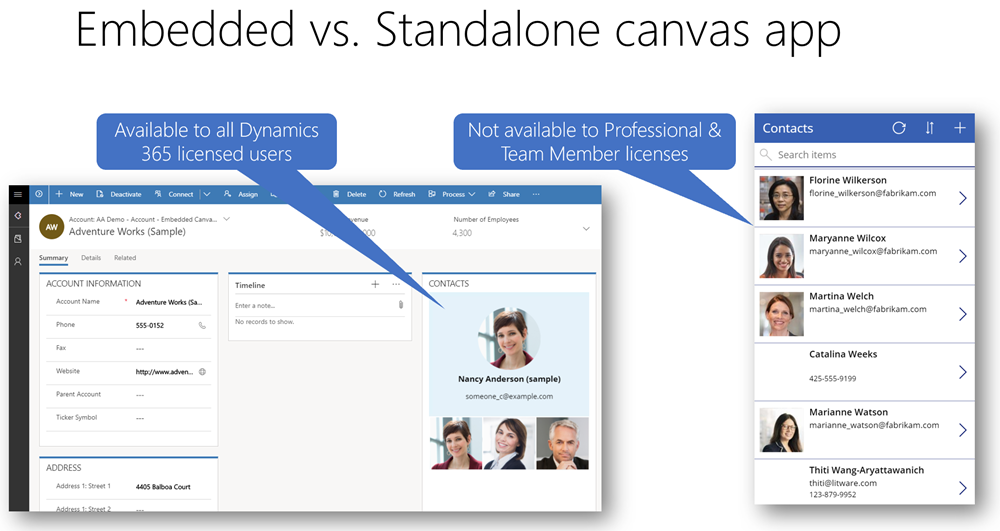
Looking at it the other way around, what Dynamics 365 style of functionality you get access to with a PowerApps license, the differences between P1 and P2 can be a bit tricky to understand in real world scenarios. Sure, P1 is limited to canvas apps usage only, but also on that side we have exclusions for restricted entities and complex entities. The concept of “complex business logic” is the real gotcha, though, as enabling real-time workflows or plug-ins for an entity will instantly switch the requirement level to P2 license. Here’s how you might fall into this trap:
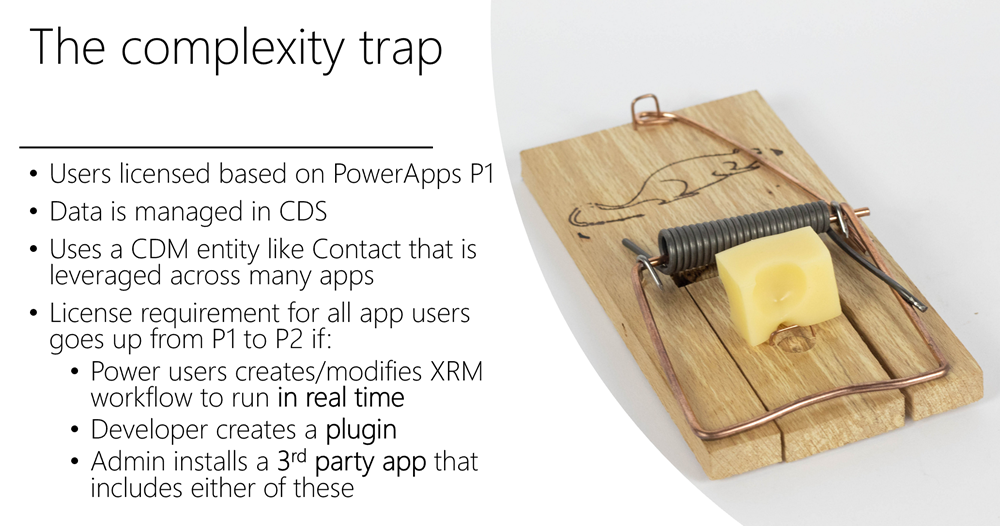
For anyone who’s either been building more advanced apps or has planned to do this and has stayed within the PowerApps & Flow licenses bundled in with Office 365 subscriptions, you’ll need to pay close attention to the updated license terms that came into effect on February 1st. In short, usage of custom connectors, HTTP custom actions and on-premises data gateway were moved to PowerApps P1 level and are no longer “free” with Office 365 plans. For a deeper dive into the practical implications of this change, be sure to check out this comprehensive licensing guide to Microsoft Flow and PowerApps by MVP Jussi Roine.
The push for getting organizations to adopt CDS environments as the basis for their PowerApps canvas apps and therefore upgrading their license package to the paid tier of PowerApps P1 will be a milestone Microsoft undoubtedly wants to reach. This can initially be a hard sell if there aren’t that many apps in production use and the cost of these advanced features would have to be absorbed into their business case calculations. However, if this can be viewed as a proper platform story that is about acquiring licenses for the common foundation of hundreds of apps to come, then the math is far more favorable.
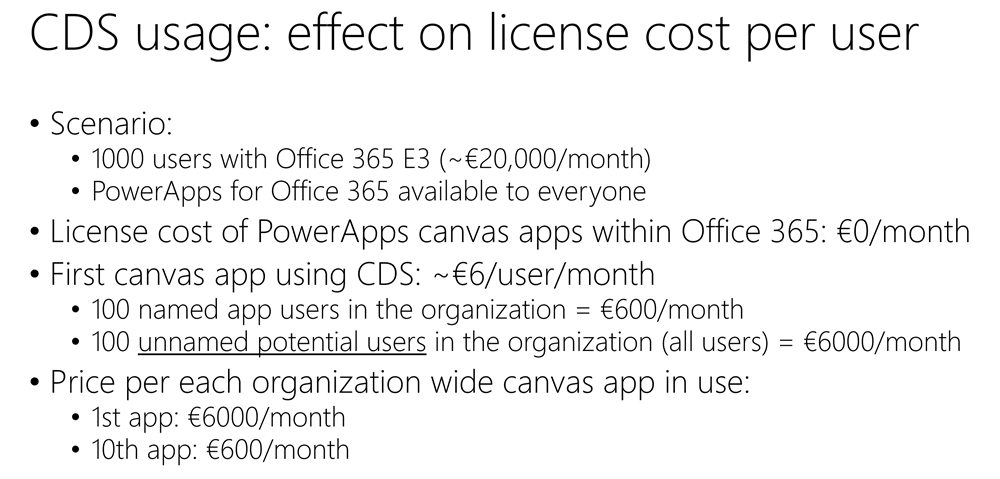
Model-driven apps and P2 of course represent another big jump in the relative cost of a single license vs. P1 and “free” Office 365 license. Then again, when viewed from a Dynamics 365 perspective, the ~€34 price of P2 is so much cheaper than a Sales Enterprise app license at €80 (and with none of the Sales Professional limitations) that even building your custom Sales app on top of the platform becomes an interesting scenario. That’s one of the changes that has take place with the Dynamics 365 licensing guide wording, as the earlier restrictions about replicating existing 1st party app features have been removed:
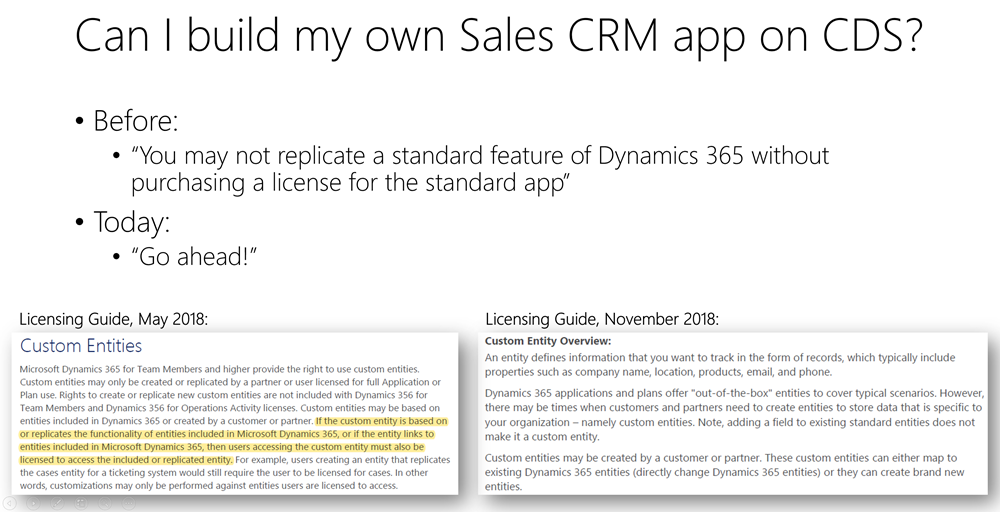
That’s it for the licensing mysteries that I had the pleasure of covering in my 365 Saturday session. Grab the full deck from SlideShare and keep in mind that by the time you read it these licensing terms may well have changed already! For example, the PowerApps licensing page on docs.microsoft.com was updated on Feb 1st and there was a new January 2019 version of the Dynamics 365 Licensing Guide published already.
Demystifying Dynamics 365 & Power Platform Licensing: Part 2
In the previous post I highlighted some of the recent updates on Dynamics 365 licensing. Now let’s
Hi Jukka,
Great insight as always.
I was listening to Mark Smith’s interview with Charles Lamanna on the Microsoft Business Applications Podcast this morning (https://www.nz365guy.com/power-platform-changes-and-answering-community-questions-with-charles-lamanna/).
If interpret what Charles is saying correct (from 33:30 – 35:00) – he’s saying that you can use the Outlook, SharePoint, Teams etc. integration with the platform license (PowerApps P2).
However, I’m not sure if he’s specifically thinking of ISV that use the integration via API/SDK or if he’s referring to the out of the box features such as App for Outlook etc.
Niels, I have heard similar comments from the product team, too. It’s just a shame that what is being shared as the intention of how the product team would envision the platform to be used isn’t yet backed up by hard evidence in the licensing documentation. There are likely still a few obstacles in the way of making this a reality, some which may be technical when it comes to feature availability in different environment configurations, and the others being the whole process of how commercial terms in a complex software stack like MS Business Applications actually can be modified.
Jukka,
You are right – but at least now we have something on record 🙂
It is kind of weird that for Dynamics 365 there is a 53 page Licensing Guide (https://mbs.microsoft.com/Files/public/365/Dynamics365LicensingGuide.pdf) – but for PowerApps, there is just a price/marketing page with some purple dots on it.
So, if you need to use the Outlook integration – but has built everything else from scratch in your own app and isn’t using any of the D365 sales functionality – what do you do? Buy the PowerApps P2 license at $40 and hope you are not violating any licensing terms – or pay the full $95 for the Dynamics 365 for Sales Enterprise just to be sure?
Steve Mordue’s comment about explaining quantum physics compares to explaining Microsoft’s licensing is spot on.